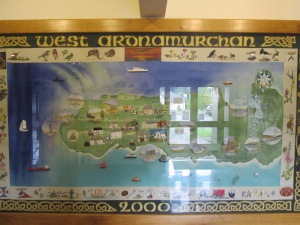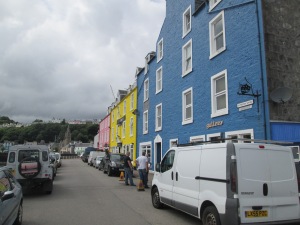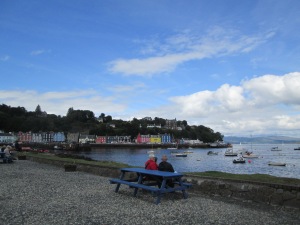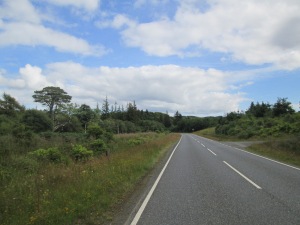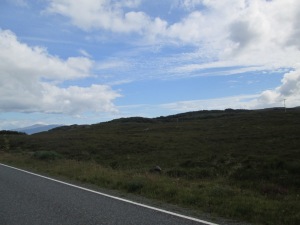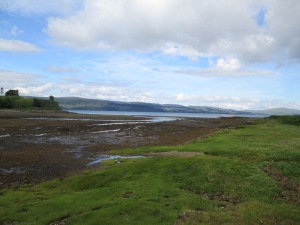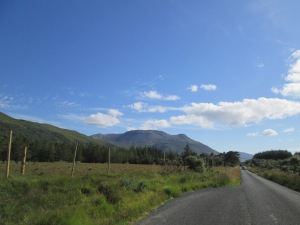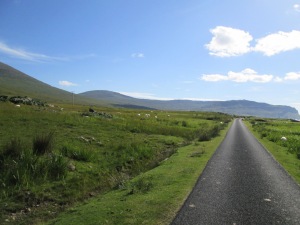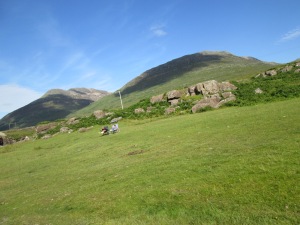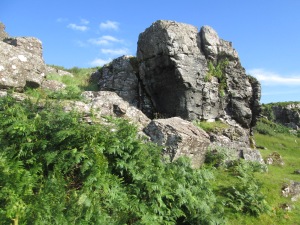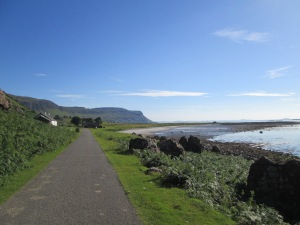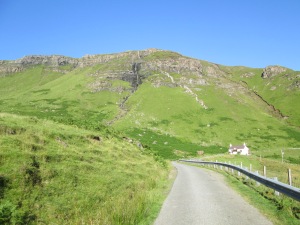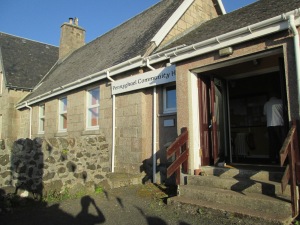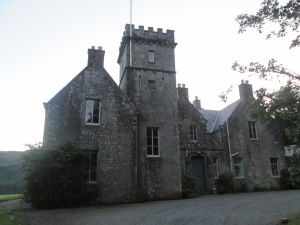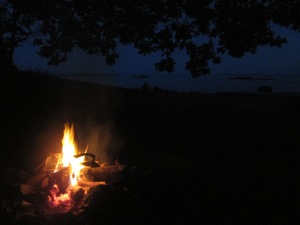‘Time, it doesn’t matter’ – Bill, the ex-lighthouse keeper, Ardnamurchan Point.
In a remote and rainswept tent, on a most remote and windswept peninsula, I awake after a night of strange and intense dreams. A combination of oscillating emotions, fatigue, and heavy intake of cheddar has shaken up my psyche.
I’m surrounded by ferns, their delicate fronds flickering in the morning’s easy breeze, but little else: a farmhouse in the far distance, a telegraph pole behind me, and the slither of a road ahead. I pack up and follow the single-track trail I’ve slept nearby, somewhere between Kilchoan and the very end of the mainland, a place called Ardnamurchan Point. It’s a bumpy track that passes the occasional field of sheep but otherwise rocks along an ancient landscape, unspoilt by KFC drive-throughs or Argos distribution centres. Occasionally some rallying bit of graffiti appears on the broken road: ‘nearly there!’ ‘go go go!’, remnants of some fun-run once? Otherwise the landscape is wild yet peaceful, a pleasure to rove up and down in the gentle and dry morning.
The narrow road eventually reaches its an end at the foot of a lighthouse and a traffic light, one that feels almost like a sarcastic joke in this most remote and undisturbed of places. It ensures that in the extremely rare event of two vehicles attempting to pass each other on the bridge to the building, no accident ensues. Well, caution is the aim here. Ardnamurchan Point is the most westerly point of the British mainland, and a small visitor centre by the lighthouse makes the most of this fact. Inside, a local girl from nearby Kilchoan sells me a ticket of admission and tells me of her enjoyment of life here. Her accent is sweet, soft and light, much milder than those one hears elsewhere in the Highlands.
The people of Ardnamurchan intrigue me. None can make out what I’m saying and insist I repeat myself. They seem eternally preoccupied with some distant mental image that evokes an intimate yet innocuous pleasure. Perhaps eternity itself preoccupies them. They keep the personal details of their lives on display but kept back in the way others will tuck in a shirt. They present themselves as content, and their conversation spills over with diamond shards of wisdom and inspired observation. Being in no mood to rush, I have a coffee for the first time in weeks. After these travels, it’s not as enjoyable as a flask of day-old tap water and a banana on the cusp of a remote peak.
The lighthouse itself is painted a creamy white and is made up of pretty Mull granite. At its foot, an Australian family of three each pose for photos until I relieve them with the offer a group shot. They’re delighted and confused by the notion that this is the most westerly point. I wonder what it is that brings them here, that would beckon anyone here. Only rumours of Ardnamurchan’s spectacular beauty. Fortunately some local authority has hunted down these rumours and kept them under lock and key. Ardnamurchan remains the greatest, most wonderful secret of the Highlands. Do not be surprised if I disappear after this post…
A steep and twirling staircase takes me and a young family up to the top. As her daughter despairs of the sheer scale and frequency of these gargantuan steps, her mother shouts ‘keep counting!’ A wizened old feller over-dressed in the outfit of a supermarket security guard with brylcreemed-back hair takes our tickets and mutters under his breath. He’s not used to being heard, but what snippets I catch are ingenious, be they on the topics of time passing, time coming, or the circular infinity of all living things, come muttered under his breath, begun with a whisper and terminated with either a polite cough or inscrutable joke.
From the top of the lighthouse we spy views of distant Rum, Eigg, Muck, Mull and beyond. The children dash about noisily with enthusiasm, filling the silent tower with life. This must cause some consternation to Bill, our guide. He once manned this lighthouse, working usually alone for fifteen years until all the lighthouses were automated in 1988. In an act of weird and unprovoked malice, he knocks the light beacon towards us. It rotates on a central axis and knocks the mother on the head. We look at each other in confusion.
I sense that he undertakes his watch today with some melancholy. Even before those fifteen years’ service, he worked here part-time. I chat to him later alone:
‘I was an occasional before that … we were often busy’.
Daytime responsibilities ranged from maintaining the lights and their paraffin, to checking the foghorn (the cessation of its use is a grave mistake, he insists). They would maintain the lighthouse and assist with local weather reports. At night, they couldn’t leave their posts. They’d gaze alone into the distant darks of the tumultuous ocean. Forty hours per week alone, largely, sharing shifts with four other men. He had some free time between, but Bill doesn’t explain what he did. ‘It’s all changed’. What? ‘It’s not what it was. I miss the boys, the craic.’ The young have to routinely leave the area now for work, and few return. He points to a set of small cast lion heads inside the lighthouse, painted black along with most of the interior. ‘They used to be bronze’, he says sadly, his words casting a wider indictment against the regretted obsolescence of his way of life.
‘Not every man is suited to be a lightkeeper’, warns an instruction manual issued back in 1986. It goes without saying that this was characteristically considered men’s work: equal opportunities seems like the stuff of NASA rockets compared to this archaic yet beguiling vocation. The Northern Lighthouse Board’s publication ‘The Lightkeeper: A Man of Parts’ gives this insight:
‘The good lightkeeper has, or acquires the temperament necessary for his job which involves residence close to the sea and much loneliness and isolation in its composition.’
But for all the knowledge of engines, radar beacons, radio telephones and cooking, the skill of a lightkeeper is in a certain philosophical outlook.
‘From his study of the sea, he will respect its immense power. … A lightkeeper will not make a fortune but he will be at peace with himself and the world.’
For more on this intriguing vocation I direct you to Peter Hill’s memoir of being a young lighthouse-keeper, Stargazing.
Ardnamurchan Point is a superb spot to watch whales and basking sharks, though the latter have been lacking in number in recent years. We each peer out from a small balcony that encircles the beacon outside. The lighthouse was built back in 1849 at the time of the Potato Famine in Scotland, and labourers were paid with bowls of oats. Eerily, it still stands imperiously as if it had been constructed a year ago, as if evidencing Bill’s claim that time doesn’t matter. As Robert Louis Stevenson, son of the family who built these structures put it,
‘For love of lovely words, and for the sake
Of those, my kinsmen and my countrymen,
Who early and late in the windy ocean toiled
To plant a star for seamen, where was then
The surfy haunts of seals and cormorants:
I on the lintel of this cot, inscribe
The name of a strong tower.’
At the foot of this Pharos, I talk again with the mother of this young family about our respective travels and trajectories. Her son has his name stencilled on the back of his football shirt. She’s enthused by the Einstein-like combination of long-distance cycling and philosophy. ‘One day you’ll do that’, she says to her boy. He smiles confusedly and I laugh. There’s something wonderful about the possibilities inherent in the lives of children, ignorant of disappointment, discrimination or being drilled and dictated to by bad teachers or managers. ‘Yes, you should!’ I tell him, hoping that this strange man’s instructions will convert him towards books, bohemia and bicycles over boredom, business and banking. Let’s hope…
I leave the lighthouse and head back down the bumpy track to Kilchoan. In the daylight I see a pretty if disparate village. A nearby community centre doubles up as a local college. I drink tea inside and chat with the elderly ladies running the place, and find out more about the area. It’s just by the ferry harbour, where a small queue of cars and their passengers mill about, waiting for the ferry to Tobermory on the isle of Mull, my next destination.
The ferry journey is short and pleasant, and from the deck a large group of us look out at pretty Tobermory harbour in the distance, primary-coloured buildings facing the sound of Mull with the sugary sweetness of Neapolitan ice-cream. Balamory, a popular children’s TV show, is based on this twee and delightful harbour village. There’s nothing tacky or crass about the place, no excessive fish and chips shops, no arcades, or attempts to capitalise on the associations of the place, which is all immensely refreshing.
There’s even a local museum which is free and very informative. It traces the histories of these islands from their first known human settlement 9 000 years ago on Rum to the burst of farming that began again 4 000 years ago across the isles. Movements of Gaelic-speaking peoples, Vikings, Scots, stranded Spaniards and, now, the modern English holiday home owner have each come to Mull and brought their culture, religious beliefs and languages with them.
One friendly volunteer overseeing the entrance of tourists into this poky and intriguing museum tells about the nature of the island today. ‘Oh, well eighty percent of people here are incomers. They speak Gaelic in schools now, but few of the older generation can. You won’t hear it here. It’s like a private language!’ An English couple nearby point to a map of the island. Tobermory sits on the north-east coastline. Their fingers slide diagonally down to Bunessen in the south-west. They have a daughter studying geology undertaking an excavation on a nearby beach. They’ve used it as an opportunity to spend time with her and get themselves sun-burnt on the nearby beaches. As we peer over the map, the number of standing stones and presence of ancient signs of settlement is apparent, compounding the historic attraction of these island to distant travellers across millennia.
Tobermory’s a pretty place to spend the afternoon in. I wander by dainty galleries and quaint souvenir stores before dropping by the harbour and its visitor centre. A grid of small sailing crafts bob in the afternoon sea, and their occupants are wandering about the place, some drifting towards a nearby pub, others heading into a new harbour centre with its showers, laundry and little exhibition space.
I head into Macgochans, a bar and restaurant perfectly situated by the harbour. Over a glass of the local Terror of Tobermory ale, I sit out in the sun and listen to the world around me. It is a ‘tolerable inn’, to use the same words as Samuel Johnson, the London litterateur who visited Tobermory on the 14th October 1773. He landed with his companion James Boswell and a local man on a tour of the Hebrides. Boswell sought to convince his portly pal that Scotland was not a ‘worse England’, as his friend originally put it, and his gambit succeeded. Despite bad weather and misadventure, in the course of three months they covered 1600 miles across the western Scotland and the isles. ‘I got an acquisition of more ideas by it than by anything that I can remember’, Johnson later reflected in Journey to the Western Isles.
Close by, one sailor stares into the distance with a degree of isolated horror. The sound of all these jovial tourists, locals and holiday-makers is clearly too bizarre, too much, after months at sea alone. A group of wacky, intriguing looking Americans sit close by. They talk Hollywood, basking a little too readily in their connections. Talk of ‘Sal’ in the Deerhunter, a strange conflation of John Cazale with his character in Dog Day Afternoon, leads to a beery exhortation among this motley crew to get beneath the skin of twee town. ‘Soon you’ll know where all the bodies are buried in Tobermory’. It’s all quite surreal.
It’s a glorious afternoon, perfect for a few hours cycling, so I decide to head out of Tobermory and follow the road south-west to Bunessen. The couple spoke of the place in terms reserved for a paradise. Though it’s probably too far to reach in a day, I decide to head that way and see what happens. ‘It makes me tired just thinking about it’, one woman tells me, when I ask for directions for the road to Bunessen. This exaggerated sense of place, and incredulity at using a bicycle to travel more than a couple of miles, remains true of folk wherever I roam. Excited by the prospect of discovering a whole new isle, I race up a steep hill that leaves the village, and pace out onto the open road.
Ah, what a journey. I won’t drag out my conclusions to the very end – Mull is just gorgeous. It may well be a perfect place to cycle, or wander, or drive, or whatever. I’ll explain why.
The road south passes a charming bay. Calve Island sits in the distance to my left, whilst the road weaves its way along an abundance of forests improbably lining this coastal road. Despite being an A-road on the map, the road is mostly single-track for most of it, with the occasional passing place for overtaking. I laugh at the strange impressions it might give international tourists of the rest of the UK’s modern road infrastructure. Further along in the distance are the ruins of Aros castle overlooking the Sound of Mull. Further south is Salen, a gorgeous village nestled in surrounding woodland and field that one could lose days exploring. There’s a bike shop here, and a place for a coffee or a bite to eat.
I head into a local shop for supplies. I meet a Yorkshire woman who very much likes the place. ‘It’s very good for cycling!’ Even the residents realise this. Does it matter that they are not native Mullonians, or Mullois, or whatever the term is? Of course not. ‘The new people they keep the place going, they give it new blood. Like it or not, this place depends on immigration. I think it’s a good thing.’
No bias right…? But comparing what I’ve seen of Tobermory and Salen so far to the Isle of Skye, I’m impressed by the more cohesive and communal feel of Mull. Nothing sprawls or spills out. There are no coach parties. Though I will pass many a motorhome tottering along this narrow tracks, I don’t feel overburdened by it. This is no tourist trap: Mull remains a secret. Yet as I found on Skye, locals were also reacting more against this. Gaelic was more widely spoken, and the Highland heritage was more avidly expressed by the local council. In all, I end up meeting more indigenous Highlanders in the B&B lands of Skye than I do on magic Mull. But Mull feels less disturbed and more at peace with itself. After Salen, most of the landscape is entirely unbuilt upon, and even the most fertile looking valleys are not troubled by cattle or sheep.
There are two roads to Bunessen, so I visit a post office to find out which to take. Anna draws me the most marvellous of maps. It makes no sense at all at first, but relies on an intuitive approach to travelling based on speed. It is far more helpful than anything I’ve picked up in a tourist office and serves me well over the rest of the afternoon and evening when the landscape really does become strange. She’s from Mull and has brought up her children here.
‘My kids, they’re 16 and 17 year old, they love it here. They go away, but they say they miss the grass, the trees. You’ve got to be content to live here, that’s what I’d say. You’ve got to have good people around you.’
Finding fulfilment in material objects like a computer or car won’t help on Mull. Nor will the aggressive pursuit of a career in some profession, industry or field of study where some other soul could succeed just as well in your place. ‘Generations pass while some trees stand, and old families last not three oaks’, Thomas Browne said in Norwich. On Mull they’re more aware of the passage of time and the transience of life, which is why they seek to enjoy the most of their landscapes, their friends and their family.
Using this strange map I head west from Salen. Road signs are stickered with love hearts like in the remotest trails of the north-west Highlands – an adorable phenomena. It passes the first Scottish church I’ve glimpsed that looks remotely inviting: ‘reverence my sanctuary’ heads the archway in. The road bends this way and that between fields where cattle and crop doze with the same lazy tranquillity in the late afternoon heat.
The terrain is always changing. I am passing through the lush and ancient trees of Killiechronan Wood, at peace with the world in this distant and joyous refuge. So far away are the horrors of the many wars being waged against innocent peoples today. So far away is London, and the objects and the responsibilities that together cast my identity. All that feels like some faraway diver’s suit into a deep and uncertain abyss I’m unsure whether to plumb. What need, when the trees of Killiechronan Wood are so delightful, their pathways so enchanting? What rush, when the gold of the sunlight flickers through the leaves and tingles your retinas with flashes of every conceivable colour?
After Killiechronan and Drumlang woods, the road terminates at the most wondrous of expanses, Loch Na Keal. It sharply judders south, and along the same single track takes the rider on the most beautiful of paths that hovers just above the sea-line. The sun casts a dazzling ray of white light that skitters across the gentle waves and collides right against the forests and mountains that line the road to the other side, crowned by the extinguished glory that was once a volcano, Ben More. The intensity of the light is intoxicating, and yields to the eye a sensory intensification of colours and sights that makes the terrain feel even more peculiar and unique.
Little Rock Pippets flutter over craggy banks of grass where sheep laze. Camper vans and tents are perched up against the golden sands that separate sea from field. The road is mostly flat and is a pure pleasure to cycle. The views of the distant islets of Eorsa and Inch Kenneth, distant Tiree, and then the Atlantic, are blissful. After Tiree the next landmass in this direction is the mischievously-named Greenland. This coastline trail is the most gentle and exquisite of the trip. By no means as overawing as the route through the Cairngorms, or as terribly and beautifully desolate as the road to and from Durness, but in itself a gentle pleasure.
After Loch Na Keal the road threads back inland, up a steep pass into the mountains, then weaves back through a dense forest, thickened with spindly trees pressed tight against one another. I am tempted to throw my bicycle down and wander through this woods with no name, but I have no idea of where I am or will be. Perhaps that’s the point. As Anne pointed out, there really is ‘nothing’ in between Salen and Pennyghael, the next settlement somewhere ahead. In fact there is everything here for an imagination reared in a farmyard, overcrowded with humankind and their mass-manufactured wants. The plains are saturated with opportunities to explore and adventure, or to sit and to stop. The air is soft and fresh, and the early evening breeze whistles a sweet music free of police alarums or the noises of neighbours. On a gentle and lovely day like this, the song is one of peace.
The scene changes again: act IV is a wide-open expanse after these forests, a great flat bay that descends into Loch Scridain, and further ahead, Loch Beg. The road bends around both lochs in the shape of a reversed letter C. The occasional cottage pocks the vista, which is one otherwise of distant mountains, waters and flattened plains. A group of young people stand by a car with binoculars, seeking sight of the sea eagles that live in unusually large numbers here. The road eventually splits, left for Craignure, right for Bunessan and the ferry to Iona. Love heart stickers indicate the westward turn to make. Come, Iona!
I pass over a small stone bridge and a surrounding scene straight from the imagination of Hans Christian Andersen, and pass into Pennyghael, a scattering of settlements across several miles that line Loch Scridain’s southern side. There’s a small post office and a shut-up hotel, energies dormant like the surrounding volcanoes. I pass a hotel with a bar, and wonder whether to stop, when a man besides a barbecue beckons me over.
‘Are you hungry?’
Is the Pope a Catholic?
Greg’s supervising the food supply outside the Pennyghael community centre, lively with people inside and out. They’re having a community event and everyone is invited. Along with local venison burgers and steaks there are veggie kebabs chequered with chunks of halloumi. As Greg turns them over and waves off payment, I head inside to find out more about the place. By the door, Sandra’s selling raffle tickets and welcoming everyone in with warmth and friendliness.
How does one come to end up in a place as wonderful as Pennyghael? For her and her partner James, a job came up on Gumtree. Wanted: reliable couple for a remote location. They’d just returned from travelling and had nowhere secure to live. It turned out to be caretaking for a grand local estate. They didn’t know Mull but took a punt, and now are in love with the place. Despite the disparate nature of the settlements, I get the impression of a strong and interwoven community here. There are often activities in the centre that focus on bringing people together over food and drink. She jokingly points to a locals table in the centre of the hall, and a table nearby for tourists, but there seems to be a degree of mixing on both sides. ‘It’s about getting the community together. We do these quite often, once a month. You’ve got to use it or lose it’. Older folks talk to younger people. It’s a bright and cheery event, and I’m inspired by it. If a rich communal life can be established on remote Mull, then its possibility is far more apparent in the deserts of England’s suburbs.
I talk outside to Marie and Philip, a middle-aged couple living near Matlock in Derbyshire. They laugh as I pinpoint the places close to where they live, amazed I suppose that a southerner has attempted to tour and explore the secrets of those scapes. It’s only been in the Highlands and Islands that people I meet reassure me that ‘it’s not mad to be doing what you’re doing!’ My conversational patter is littered with jokes and self-deprecation, a proven way of relaxing the encounter. But in these parts I’m more often corrected than not, reassured that this kind of travel is a superb thing and the knackered bicycle the best way of doing it. Why?
Many here are far more well-travelled than most. They’ve searched the continents of the world for sources of adventure, difference, or peace, dependent on the seasons of their lives and their moods. Many have worked or lived in Australia, Canada, the United States, Europe, India and elsewhere. They’ve left their birthplaces in southern Scotland and England and ended up here, in the Highlands, in the Hebrides. Come to these parts and explore them, and you too may become possessed by the same desires.
Philip and Marie are staying for five nights in Bunessen but already ‘wish we had longer’. As Philip heads indoors to bring us both some beers, me and Marie reflect on these environs. Back in Derbyshire ‘we don’t have anything like this there’. ‘No nor with us’, I reply. They have three children in their twenties living in London and the north, and they worry for their future. They’ve worked and saved to help them ‘get on the property ladder’, a way of securing a stable future for them, but it’s been difficult. One son is an overqualified marine cameraman but doesn’t earn enough from his passion to live. He has to take holidays from his conventional job in order to build his portfolio in the hope of one day getting a full-time job using his skills.
‘There’s so many interviews, they all tell him you’ve got too much experience, why are you doing this? But he just wants to get his foot on the ladder’.
By contrast, their lives more secure. They’re part of a generation born in the 1950s and 60s that could put a step on the ‘property ladder’. ‘I wonder if it’s all over, if it’s a golden age that’s come to an end’, ponders Philip. I agree to an extent, but I tell them that there’s no sign that the rapidly rising prices in London are about to burst. It’s become even more firmly entrenched as a second economy for Londoners as jobs become more insecure and pensions more precarious.
I explain about my parents, each of which now owns their place in London (which, by economic definition I suppose, makes me middle class). My mum holds sound left-wing views but is thinking ahead to her retirement, and to what she can do to help her three children out in the future. She’s planning to borrow money to redevelop her house in Camberwell and transform, in effect, the loft into a floor and extend the house into the garden. If prices remain the same, it’ll add a third of value to the place. At current rates, estate agents reckon it could sell for three quarters of a million, though my folks bought the place for seventy grand twenty-two years ago.
I tell them about a suggestion made to me and my partner by a good friend, to consider buying outright our council flat. (With what money though?) Situated close to the tube in inner London, it could net us enough to establish a new life with. But, it betrays the ethics of public housing which have assisted us in times of need, and spits in the face of the ideals of social democracy that for a brief couple of decades after world war two ran as the prevailing thought in local government policy.
Philip ponders silently for a time then shares the sum of his thoughts.
‘You’ve got ethics. You’ve thought about things, and you’re doing philosophy, and looking at communities. But you’ve got to look at the real world. People don’t do things ethically half the time, they don’t do what they should’.
‘Yeah I know, it’s about tying democratic decisions, communities, with these selfish motives we naturally have’.
He nods his head. Another guy nearby chips into the conversation. His family have moved to London from Glasgow and are living in one of the new-builds by Stratford in London’s redeveloped East End. He has a more rosy though false impression of the abundance of social housing in London. Marie offers her thoughts, and notes that having children will transform one’s views. ‘Once you’ve got kids, you’ll do anything for them. They come first. And that means, you know, using property, whatever you can, to help them on their way.’
The evening sun and the nearby scents of the barbecue are scintillating, and the beers unfurl casual conversation into even more distant diversions. Talk twists to the decline of casual violence compared to the seventies, an effect they ascribe to the growth of CCTV. Even if the cameras don’t work, Philip muses, there’s a fear that they might be, that you’re being watched. And it’s worked.’ I can’t help agreeing. Surveillance is insidious and would seem unnecessary, but burglaries, robberies and violent assaults have all diminished in the last two decades, if we follow not just what counts as recorded crime, but crime surveys of the population in all. The internal surveillance of a socialised Christian belief in God and hell has been slowly substituted with an external surveillance of a fear of prison and the omniscience of the law.
But being parents and talking to someone of a similar age to their children, conversation creeps back to generational differences and their worries for the future.
‘They’ve just ripped up all the rights up. It was companies during the recession, to survive they began to cut corners. The quality of the job you’re employed to do declined.’
What could change this? Legislation, though the possibility of re-regulating labour rights elicits a melancholy smirk. Philip suggests the German model of work as a possibility, based on his experiences in a German firm: ‘they put so much more resources into supporting you’. A nearby woman chips into our conversation. In Germany, the state pays ninety percent of a person’s salary for the first year when they’re unemployed. Afterwards it’s cut off, but ‘it means people don’t have to panic or get into huge levels of debt’.
Fascinating, the abundance of conversations and the popularity of political debate wherever you go. No-one here is ‘qualified’ in an educational sense to speak on work, politics or ecology, but each person who chips in has an opinion more insightful or incisive than anything found in a London rag. The barbecue starts to wrap up. I talk to James, partner of Sandra, who suggests Carsaig pier as the most perfect place to wild-camp.
‘Don’t go to Bunessen. There’s nothing like this place.’ He gives me instructions to find it. It’ll be a detour and involves a steep three mile climb but, fuck it, I’m intrigued by the risk and the promised prize. Nearby I talk to Charlie, a local man born here but who lived in London for a long time, studying art, though, as he admits, mainly ‘wasting around, on the dole a lot’, he jokes. It seems like things didn’t work out there, but he doesn’t hint why. He’s more curious of me, a London beast who has improbably washed up on his part of the world. As I often find, telling people that I’m studying political philosophy at PhD level tends to elicit some kind of discussion on political ethics. I absolutely love it. Charlie’s interested in the ethics of taxation.
‘Tell me, should the government have the right to go to a person, take their money, and give it to this person here?’
‘Yes, if that government has directly popular backing and an agreement to organise that society. That means that it will redistribute resources and wealth, you know, offer a kind of social contract, one that educates citizens, helps them find work, supports them with caring or childcare, and aids them in ill-health into retirement, that kind of thing.’
Somewhat satisfied with that answer, he offers another riddle loaded on all sides. ‘Ok, well should the government have the right to tell people what to think?’
‘Yes, to an extent. In a society people come together to live under a shared law and political agreement. In the UK, we don’t have one, that’s part of the problem. The rich inherit wealth and public stuff is privatised and we have nothing except a dodgy set of precedents and a bunch of crooks in Westminster to make em accountable. But that’s the problem of democracy. Democracy means not every decision that goes through is what we want, but that’s the price. So long as it’s not religion, as long as the government isn’t forcing us to believe, that’s ok.’
This natural libertarian is less sure here, as am I. Conversation kindles on music and playing in London bands. I imagine a young man fifteen years back, afternoons smoking spliffs in a cheap as chips Hackney Wick studio, of ill-attended gigs in west London boozers, of squat parties that went on for days and days, too wired to sleep, the bass and rhythm possessing the mind up like the cordyceps funghi, forcing legs and torsos to twist and gyrate of their own accord in time with the rhythm.
I leave Pennyghael hall and follow James’ simple directions, taking a left for Carsaig and, bloody hell, ascending up the steepest and most calamitous of broken roads. It’s exhausting work and continues for several miles. The trail bores a narrow track through the thickest of forests before suddenly reaching the end of the horizon. Below is the steepest of drops, zipping in zigzags this way and that, passing the grand houses of the Carsaig estate, a red phone box flanked by a waterfall (‘there’s no point calling anyone on it, cos they won’t hear a thing except the rush of water!’ James tells me). It zips down again towards a small pier and Victorian boathouse, facing the most beautiful of bays.
Fran and James sit tending a fire nearby, and another tent is camped just by the shoreline. I gaze into Carsaig Bay, and a seal pokes her or his head up and gazes back at me. What a wonderful place, peaceful and serene in the evening’s light blues and golds. They smile as they see me. ‘We could hear your brakes a mile off’, laughs James. I’d skidded precariously down the vertical drops earlier. They beckon me over and the glow of the flames is delightful. As we perch close to the fire, James points out the sounds of a tawny owl and identifies male from female. Tales are told as James tenders the embers.
He owns his own company, and his voice betrays the expense of a good education. When I describe my planned circumnavigation further south, he suggests I check the Foy regatta in Cornwall. The people one mixes with! That’s the delight of travelling. From the very wealthiest to those ready to give away what little they have in exchange for kindness, travellers meet and exchange their currency of stories with a benign egalitarianism. He’s not much older than me, and Fran heard about this place through the Lonely Planet guide. Clearly rumours of this magical Mull are spreading. They’re open-minded and friendly folk. ‘So different to London’, we agree. They’re intrigued by how I manage to survive alone. ‘How many punctures have you had?’, smiles Fran. ‘What do you eat?’ wonders James. ‘Where do you sleep?’
Ah, the joy of it all is that it’s places like Carsaig Pier that I sleep. It’s very cheap community centre kebabs that I eat, or failing that, a good bag of chips. They retire to their camper van and I watch over the fire for a little while, poking aimlessly into the heart of their flames, before returning refreshed to my own tent by the sea. This day has been more wonderful than any I can remember on this journey.





































